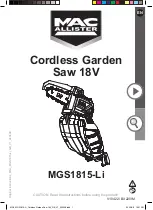
e)
Breathing protection must be worn if the power
tool is used without a dust removal system for
work that creates dust.
f)
Improve the blood circulation in your fingers by
relaxing your hands and exercising your fingers
during breaks between working.
g)
Operate the power tool only as intended and when
it is in faultless condition.
h)
Wear protective gloves when changing insert
tools as the insert tools get hot during use.
i)
Switch the power tool on only after bringing it into
the working position.
j)
Engage the safety lock before storing or trans-
porting the tool.
k)
Avoid unintentional starting. Never carry the
power tool with your finger on the control
switch. Remove the battery from the power
tool during work breaks, before carrying out
maintenance, before changing cutting tools and
before transporting the power tool.
l)
Children must be instructed not to play with the
power tool.
m)
The power tool is not intended for use by children,
by debilitated persons or those who have received
no instruction or training.
n)
WARNING: Some dust created by grinding, sand-
ing, cutting and drilling contains chemicals known
to cause cancer, birth defects, infertility or other
reproductive harm; or serious and permanent res-
piratory or other injury.
Some examples of these
chemicals are: lead from lead-based paints, crys-
talline silica from bricks, concrete and other masonry
products and natural stone, arsenic and chromium
from chemically-treated lumber. Your risk from these
exposures varies, depending on how often you do
this type of work.
To reduce exposure to these
chemicals, the operator and bystanders should
work in a well-ventilated area, work with ap-
proved safety equipment, such as respiratory pro-
tection appropriate for the type of dust generated,
and designed to filter out microscopic particles
and direct dust away from the face and body.
Avoid prolonged contact with dust. Wear protec-
tive clothing and wash exposed areas with soap
and water.
Allowing dust to get into your mouth,
eyes, or to remain on your skin may promote absorp-
tion of harmful chemicals.
6.2.2 Power tool use and care
a)
Secure the workpiece. Use clamps or a vice to
secure the workpiece.
The workpiece is thus held
more securely than by hand and both hands remain
free to operate the power tool.
b)
Check that the insert tools used are compatible
with the chuck system and that they are secured
in the chuck correctly.
6.2.3 Special safety instructions for reciprocating
saws
a)
Always guide the power tool away from your body
when working with it.
b)
Never position your hands ahead of or on the saw
blade.
c)
Never cut into unknown materials and keep the
line of cut above and below the workpiece free of
obstacles.
If the saw blade strikes an object it may
cause the power tool to kick back.
d)
Apply moderate pressure and set the power tool
to a suitable stroke rate when using the pipe-
cutting adapter (accessory), especially when cut-
ting large-diameter pipes.
This will help to prevent
the power tool overheating.
e)
The power tool must be pressed against the work-
piece until the AVR contact shoe makes firm con-
tact.
This helps ensure maximum safety and good
performance.
f)
Wear suitable protective clothing to protect you
from hot cuttings.
g)
Never use the power tool without a fully functional
hand guard.
h)
Before beginning the work, check the hazard clas-
sification of the dust that will be produced. Use
an industrial vacuum cleaner with an officially
approved protection classification in compliance
with locally applicable dust protection regula-
tions.
i)
WARNING!When cutting through pipes, e.g. when
carrying out demolition or installation work, check
to ensure that the pipes no longer contain liq-
uids and empty them if necessary. When cutting
through pipes, hold the power tool above the level
of the pipe you are cutting through.
The power
tool incorporates no protective measures to prevent
ingress of water or dampness. Liquids running out of
pipes may cause a short circuit in the power tool.
j)
Do not use the power tool to cut bricks, concrete,
cellular concrete, natural stone or tiles.
k)
Do not attempt to cut material thicker than the
specified max. thickness for which the saw is
designed and do not use unsuitable saw blades
(reciprocating saw blades of the wrong size or not
equipped with a ¹⁄₂" connection end).
l)
The transport lock should always be engaged
when the power tool is not in use.
6.2.4 Battery tool use and care
a)
Observe the special instructions applicable to the
transport, storage and use of Li-ion batteries.
b)
Do not expose batteries to high temperatures or
fire.
This presents a risk of explosion.
c)
Do not disassemble, squash or incinerate batter-
ies and do not subject them to temperatures over
80°C.
A risk of fire, explosion or injury through con-
tact with caustic substances may otherwise result.
d)
Do not use batteries other than those approved
for use with the applicable power tool or appli-
ance.
Use of other batteries or use of the battery for
purposes for which it is not intended presents a risk
of fire and explosion.
e)
Do not charge or continue to use damaged bat-
teries (e.g. batteries with cracks, broken parts,
bent or pushed-in and/or pulled-out contacts).
en
6
Printed: 08.07.2013 | Doc-Nr: PUB / 5071341 / 000 / 02



































